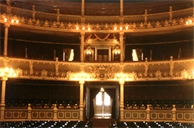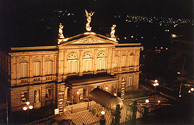
|
|
he National Theater was officially inaugurated on October 21, 1897,
thus culminating many years of planning, |
embellishing and political and economic maneuverings.
Going back further in time, Costa Rica experienced great cultural isolation
due to various factors, among the religious restrictions. Nevertheless,
in the first half of the nineteenth century, initial efforts were made
in the areas of acting and drama, which small performances in houses or
in the open air. Instead of diminishing their interest in drama for lack
of a playhouse, Costa Ricans were very attracted to the stage arts; people
would carry chairs to an improvised shed to attend performances. (It was
1846 when a woman first appeared on stage in Costa Rica, an event that
was strongly criticized by the Church).
In the 1840s, political and economic changes introduced Costa Rica to
the rest of the world. As a result of increasing coffee exports and the
arrival of foreign travelers, borders became less oppressive and a cultural
awakening, with new ideas and literary works, developed. The press and
universities were in their first stages; independence, political instability
and various coups d`état were part of the atmosphere previous to
democracy. A nation was shaping itself. It was in this context that in
1847 the idea of building a theater first took form.
| Presidents and heads of state like Dr. José María
Castro Madriz and General Tomás Guardia, among others, were |
 |
always supportive of the idea of building an appropriate palais díart,
even if there was not always political consensus. |
But before there was a National Theater,other attempts were made to
build a place to create the artistic splendor and magic that Costa Ricans
so loved.
In 1850, the Teatro Municipal, though a small and hardly adequate facility,
fulfilled the needs of a country that longed to see the performances of
internacional and local artists. However, in 1888 it was razed because
of deterioration from earthquakes. As a result, international artists and
companies no longer included Costa Rica in their itineraries, increasing
the urgency of Costa Ricans to build a new theater. The fact that the famous
prima donna Adelina Patti rejected a proposal to perform in a provisional
theater only created added impetus.
From the on, several serious attempts were made to get financing for
a new performing hall. At first, a tax on coffee exports was proposed,
which brought an agitated debate to the national congress, and later on,
was influential in the mistaken concept that coffee covered the total cost
of the theater. It was not until 1893 that president José Juaquín
Rodriguez decreed a general tax on all the costs of the construction.
In november 1890, a commission decided upon the location of the new
National Theater. It was to be located diagonally across from the former
Santo Tomás University, in the center of San José
| A year later, the first work started under the supervision
of the PublicWorks Board, appointed by the government. |
 |
The technical department of the board was in charge of designing the
plans for the National Theater, in spite of many proposals |
from renowned professionals like Enrique Invernizio and Francisco Durini,
who would later be very helpful in the final stages of the project.
In spite of the enthusiasm and hard work, construction continued not
without serious problems and setbacks. The press seriously criticized the
work and complained about the size of the stage, inefficient acoustics
and weak foundations, which were just a few of the many architectural and
engineering headaches builders had to contend with. The whole affair ended
in 1895 with the hiring of Ruy Cristóforo Molinari, an italian architect
and theater expert.
Every single detail, like the installation of the lighting system in
the facade and the arrival of the theaterís new ornamentation at the port
of Limón, was followed closely by Costa Ricans. Their expectations
were increasingly turning into impatience; they had waited seven years
for their theater to be completed.
|